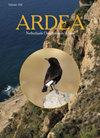黑背小鸥的年周期、繁殖生物学和摄食生态学
IF 1.3
4区 生物学
Q3 ORNITHOLOGY
引用次数: 1
摘要
荷兰小黑背鸥的数量增加引发了对生活史、迁徙运动和觅食生态的调查,在特塞尔岛(瓦登海)进行了16年的巢监测、彩色铃声和gps跟踪。主要目标是在年周期、资源变化、猎物类型和生境利用的背景下获得有关繁殖表现的综合生态数据。移徙战略包括短途(法国、英国)、中期(葡萄牙、西班牙)和长途(西北非洲),利用海洋、沿海或陆地的区域特定资源。幼鸟的平均飞行距离比老鸟更远。发现了很强的群体内亲缘关系,这在雄性中最强。对配偶忠诚度的评估表明了连续的社会一夫一妻制。出乎意料的是,当研究开始时,考虑到种群增长的趋势,羽化率很低,蛋量下降,孵化小,羽化质量下降,高水平的同类相食表明了结构性食物压力。在历史研究中,雏鸡的羽翼质量远低于雏鸡,这表明供应不足。繁殖是高度同步的,早筑巢的比晚筑巢的更年轻。多年来,繁殖的开始明显推迟,雏鸟的掠夺率下降,总体繁殖成功率变得更加可变。海洋,城市和农村的栖息地,大多在80公里以内的殖民地用于觅食。海洋猎物,主要是渔业丢弃物,是大多数鸟类的主要猎物,其次是在农业地区找到的食物。只有7%的猎物样本中发现了人类排泄物。海洋猎物的持续减少(与发展中的渔业限制一致),加上指向食物压力的信号,表明该种群无法利用目前存在的觅食机会提高繁殖成功率。本文章由计算机程序翻译,如有差异,请以英文原文为准。
The Annual Cycle, Breeding Biology and Feeding Ecology of the Lesser Black-Backed Gull Larus fuscus
The population increase of Lesser Black-backed Gulls in The Netherlands triggered investigations into life-history, migratory movements and foraging ecology during 16 years of nest-monitoring, colour-ringing and GPS-tracking on the island of Texel (Wadden Sea). The main objective was to obtain comprehensive ecological data on breeding performance within the context of the annual cycle, shifts in resources, prey types and habitat use. Migration strategies ranged from short- (France, England), medium- (Portugal, Spain) to long-distance (NW Africa), utilising marine, coastal or terrestrial, region-specific resources. Young birds travelled on average further than older individuals. Strong within-colony philopatry was found, this was strongest in males. Assessments of mate-fidelity indicated serial, social monogamy. Unexpectedly, given increasing population trends when the study commenced, fledging rates were low and declining egg volumes, smaller hatchlings, declining mass at fledging and high levels of cannibalism indicated structural food stress. Fledgling mass was well below that of chicks in historical studies, suggesting insufficient provisioning. Breeding was highly synchronised and early nesters fledged more young than late pairs. The onset of breeding was significantly delayed over the years, chick depredation rates declined, overall breeding success became more variable. Marine, urban and rural habitats, mostly within 80 km from the colony were used for foraging. Marine prey, mostly fisheries discards, formed the principal prey for most birds, supplemented with food found in agricultural areas. Human waste was found in only 7% of prey samples. A consistent decline of marine prey (in line with developing restrictions in fisheries), combined with signals pointing at food stress, suggests that the population is unable to boost reproductive success with currently existing foraging opportunities.
求助全文
通过发布文献求助,成功后即可免费获取论文全文。
去求助
来源期刊

Ardea
生物-鸟类学
CiteScore
2.10
自引率
0.00%
发文量
49
审稿时长
>12 weeks
期刊介绍:
Ardea is the scientific journal of the Netherlands Ornithologists'' Union, and is published since 1912. The journal welcomes manuscripts reporting significant new findings in ornithology, in particular those covering the ecology, life history, and evolution of birds, and including sound descriptive work. Ardea publishes Original research papers, Short notes and Book reviews. In addition to the regular three issues per year, Ardea publishes specials that contain conference or workshop proceedings (produced on request).
 求助内容:
求助内容: 应助结果提醒方式:
应助结果提醒方式:


